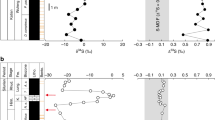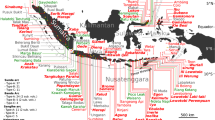Abstract
Volcanism on early Earth should have had an impact on atmospheric chemistry, but that impact can be challenging to reconstruct. The isotopic composition of sulphur contained in rocks deposited more than 2.45 billion years (Gyr) ago shows both mass-dependent (as denoted by δ34S) and mass-independent (Δ33S) isotopic fractionation. This sulphur is predominantly in the form of suphides. These sulphides show a positive correlation between δ34S and Δ33S between 4.0 and 2.45 Gyr ago. Sulphates deposited episodically between about 3.5 and 3.2 Gyr ago indicate a more homogeneous sulphur reservoir and show no correlation to the sulphide trend. Here we report sulphur isotope values of sulphide from volcanic ash layers in the 3.2-Gyr-old Mapepe Formation of South Africa. We find a δ34S–Δ33S relationship that deviates from previous sulphide isotope records and instead overlaps with the range of values reported for sulphates. Coexisting sulphates and sulphides of a similar age found in Australia and India show a similar array of δ34S–Δ33S values. We suggest that the occurrence of this δ34S–Δ33S array reflects widespread, ultraviolet-light-triggered photodissociation of sulphur dioxide that was released into the atmosphere by short-lived but intense bursts of subaerial volcanic activity.
This is a preview of subscription content, access via your institution
Access options
Subscribe to this journal
Receive 12 print issues and online access
$259.00 per year
only $21.58 per issue
Buy this article
- Purchase on Springer Link
- Instant access to full article PDF
Prices may be subject to local taxes which are calculated during checkout




Similar content being viewed by others
References
Farquhar, J., Bao, H. & Thiemens, M. H. Atmospheric influence of Earth’s earliest sulfur cycle. Science 289, 756–758 (2000).
Farquhar, J. et al. Isotopic evidence for Mesoarchaean anoxia and changing atmospheric sulphur chemistry. Nature 449, 706–709 (2007).
Ohmoto, H., Watanabe, Y., Ikemi, H., Poulson, S. R. & Taylor, B. E. Sulphur isotope evidence for an oxic Archaean atmosphere. Nature 442, 908–911 (2006).
Halevy, I., Johnston, D. T. & Schrag, D. P. Explaining the structure of the archean mass-independent sulfur isotope record. Science 204–207 (2010).
Ono, S. et al. New insights into Archean sulfur cycle from mass-independent sulfur isotope records from Hamersley Basin, Australia. Earth Planet. Sci. Lett. 213, 15–30 (2003).
Kaufman, A. J. et al. Late Archean biospheric oxygenation and atmospheric evolution. Science 317, 1900–1903 (2007).
Ueno, Y. et al. Geological sulfur isotopes indicate elevated OCS in the Archean atmosphere, solving faint young sun paradox. Proc. Natl Acad. Sci. USA 106, 14784–14789 (2009).
Lyons, J. R. Mass-independent fractionation of sulfur isotopes by isotope-selective photodissociation of SO2. Geophys. Res. Lett. 34, L22811 (2007).
Lyons, J. R. Atmospherically-derived mass-independent sulfur isotope signatures, and incorporation into sediments. Chem. Geol. 267, 164–174 (2009).
Shen, Y., Buick, R. & Canfield, D. E. Isotopic evidence for microbial sulphate reduction in the early Archaean era. Nature 410, 77–81 (2001).
Shen, Y., Farquhar, J., Masterson, A. L., Kaufman, A. J. & Buick, R. Evaluating the role of microbial sulfate reduction in the early Archean using quadruple isotope systematics. Earth Planet. Sci. Lett. 279, 383–391 (2009).
Ueno, Y., Ono, S., Rumble, D. I. & Maruyama, S. Quadruple sulfur isotope analysis of ca. 3.5 Ga Dresser formation: New evidence for microbial sulfate reduction in the early Archean. Geochim. Cosmochim. Acta 72, 5675–5691 (2008).
Runnegar, B., Dollase, W. A., Ketcham, R. A., Colbert, M. & Carlson, W. D. Early Archaean sulfates from Western Australia first formed as hydrothermal barites not gypsum evaporites. Geol. Soc. Am. Abs. Vol. 33, 404 (2001).
Bao, H., Rumble, D. III & Lowe, D. R. The five stable isotope compositions of fig tree barites: Implications on sulfur cycle in ca. 3.2 Ga oceans. Geochim. Cosmochim. Acta 71, 4868–4879 (2007).
Philippot, P. et al. Early Archean microorganisms preferred elemental sulfur, not sulfate. Science 317, 1534–1537 (2007).
Wacey, D., McLoughlin, N., Whitehouse, M. J. & Kilburn, M. R. Two coexisting sulfur metabolisms in a ca. 3400 Ma sandstone. Geology 38, 1115–1118 (2010).
Golding, S. D. et al. in Earliest Life on Earth: Habitats, Environments and Methods of Detection (eds Golding, S. D. & Glikson, M.) 15–49 (Springer, 2011).
Huston, D. L. & Logan, G. A. Barite, BIFs and bugs: Evidence for the evolution of the Earth’s early hydrosphere. Earth Planet. Sci. Lett. 220, 41–55 (2004).
Farquhar, J., Savarino, J., Airieau, S. & Thiemens, M. H. Observation of wavelength-sensitive mass-independent sulfur isotope effects during SO2 photolysis: Implications for the early atmosphere. J. Geophys. Res. 106, 32829–32839 (2001).
Kamber, B. S. & Whitehouse, M. Micro-scale sulphur isotope evidence for sulphur cycling in the late Archean shallow ocean. Geobiology 5, 5–17 (2007).
Masterson, A. L., Farquhar, J. & Wing, B. Sulfur mass-independent fractionation patterns in the broadband UV photolysis of sulfur dioxide: Pressure and third body effects. Earth Planet. Sci. Lett. 301, 253–260 (2011).
Heinrichs, T. K. & Reimer, T. O. A sedimentary barite deposit from the Archean Fig Tree Group of the Barberton Mountain Land (South Africa). Econ. Geol. 72, 1426–1441 (1977).
Lowe, D. R. & Nocita, B. W. in Geologic Evolution of the Barberton Greenstone Belt, South Africa, Vol.329 (eds Lowe, D. R. & Byerly, G. R.) 233–258 (Geol. Soc. Am. Spec., 1999).
Philippot, P. et al. Drilling Archean stratigraphic horizons: Pilbara Craton, Western Australia and Barberton Belt, South Africa. C. R. Palevol. 8, 649–663 (2009).
Mojzsis, S. J. Sulfur on early Earth. Earth’s Oldest Rocks, Vol.15 923–970 (Elsevier, 2007).
Hoering, T. C. The isotopic composition of bedded barites from the Archean of southern India. J. Geol. Soc. India 34, 461–466 (1989).
Deb, M., Hoefs, J. & Baumann, A. Isotopic composition of two Precambrian stratiform barite deposits from the Indian shield. Geochim. Cosmochim. Acta 55, 303–308 (1991).
Lowe, D. R. & Byerly, G. R. Geologic Evolution of the Barberton Greenstone Belt, South Africa (The Geological Society of America, 1999).
Lowe, D. R. & Byerly, G. R. Early Archean silicate spherules of probable impact origin, South Africa and Western Australia. Geology 14, 83–86 (1986).
Xie, X., Byerly, G. R. & Ferell, R. E. Jr IIb trioctahedral chlorite from the Barberton greenstone belt: Crystal structure and rock composition constraints with implications to geothermometry. Contr. Mineral. Petrol. 126, 275–291 (1997).
Tice, M. M., Bostick, B. C. & Lowe, D. R. Thermal history of the 3.5–3.2 Ga Onverwacht and Fig Tree Groups, Barberton greenstone belt, South Africa, inferred by Raman microspectroscopy of carbonaceous material. Geology 32, 37–40 (2004).
Kröner, A., Byerly, G. R. & Lowe, D. R. Chronology of early Archaean granite-greenstone evolution in the Barberton Mountain Land, South Africa, based on precise dating by single zircon evaporation. Earth Planet. Sci. Lett. 103, 41–54 (1991).
Van Kranendonk, M., Philippot, P., Lepot, K., Bodorokos, S. & Pirajno, F. Geological setting of Earth’s oldest fossils in the c. 3.5 Ga Dresser Formation, Pilbara Craton, Western Australia. Precambr. Res. 167, 93–124 (2008).
Partridge, M. A., Golding, S. D., Baudlys, K. A. & Young, E. Pyrite paragenesis and multiple sulfur isotope distribution in late Archean and early Paleoproterozoic Hamersley Basin sediments. Earth Planet. Sci. Lett. 272, 41–49 (2008).
Ono, S., Kaufman, A. J., Farquhar, J., Sumners, D. Y. & Beukes, N. J. Lithofacies control on multiple-sulfur isotope records and Neoarchean sulfur cycles. Precambr. Res. 169, 58–67 (2009).
Bao, H., Sun, T., Kohl, I. & Peng, Y. Early Archean microorganisms preferred elemental sulfur, sulfate, both, or neither. Science 319, 1336b (2008).
Johnston, D. Multiple sulfur isotopes and the evolution of Earth’s surface sulfur cycle. Earth Sci. Rev. 106, 161–183 (2011).
Van Kranendonk, M. J., Smithies, R. H., Hickman, A. H. & Champion, D. C. Review: Secular tectonic evolution of Archean continental crust: Interplay between horizontal and vertical processes in the formation of the Pilbara Craton, Australia. Terra Nova 19, 1–38 (2007).
Isley, A. E. & Abbott, D. H. Plume-related mafic volcanism and the deposition of banded iron formation. J. Geophys. Res. 104, 15461–15477 (1999).
Thomazo, C., Ader, M., Farquhar, J. & Philippot, P. Methanotrophs regulated atmospheric sulfur isotope anomalies during the Mesoarchean (Tumbiana Formation, Western Australia). Earth Planet. Sci. Lett. 279, 65–75 (2009).
Domagal-Goldman, S. D., Kasting, J. F., Johnston, D. & Farquhar, J. Organic haze, glaciations and multiple sulfur isotopes in the Mid-Archean Era. Earth Planet. Sci. Lett. 269, 29–40 (2008).
Ono, S., Beukes, N. J. & Rumble, D. III Origin of two distinct multiple-sulfur isotope compositions of pyrite in the 2.5 Ga Klein Naute Formation, GriqualandWest Basin, South Africa. Precambr. Res. 169, 48–59 (2009).
Ono, S., Wing, B., Johnston, D., Farquhar, J. & Rumble, D. III Mass-dependent fractionation of quadruple stable sulfur isotope system as a new tracer of sulfur biogeochemical cycles. Geochim. Cosmochim. Acta 70, 2238–2252 (2006).
Ono, S., Beukes, N. J., Rumble, D. III & Fogel, M. Early evolution of atmospheric oxygen from multiple-sulfur and carbon isotope records of the 2.9 Ga Mozaan Group of the Pongola Supergroup, Southern Africa. South African J. Sci. 109, 97–98 (2006).
Papineau, D. & Mojzsis, S. J. Mass-independent fractionation of sulfur isotopes in sulphides from the pre-3370 Ma Isua Supracrustal Belt, West Greenland. Geobiology 4, 227–238 (2006).
Papineau, D., Mojzsis, S. J., Coath, C. D., Karhu, J. A. & McKeegan, K. D. Multiple sulfur isotopes of sulfides from sediments in the aftermath of Paleoproterozoic glaciations. Geochim. Cosmochim. Acta 69, 5033–5060 (2005).
Mojzsis, S. J., Coath, C. D., Greenwood, J. P., McKeegan, K. D. & Harrison, T. M. Mass-independent isotope effects in Archean (2.5 to 3.8 Ga) sedimentary sulfides determined by ion microprobe analysis. Geochim. Cosmochim. Acta 67, 1635–1658 (2003).
Hu, G., Rumble, D. III & Pei-Ling, W. An ultraviolet laser microprobe for the in situ analysis of multisulfur isotopes and its use in measuring Archean sulfur isotope mass-independent anomalies. Geochim. Cosmochim. Acta 67, 3101–3117 (2003).
Cates, N. L. & Mojzsis, S. J. Chemical and isotopic evidence for widespread Eoarchean metasedimentary enclaves in southern West Greenland. Geochim. Cosmochim. Acta 70, 4229–4257 (2006).
Whitehouse, M. J., Kamber, B. S., Fedo, C. M. & Lepland, A. Integrated Pb- and S-isotope investigation of sulphide minerals from the early Archaean of southwest Greenland. Chem. Geol. 222, 112–131 (2005).
Acknowledgements
P.P. acknowledges support from the Centre National de la Recherche Scientifique, the Institut de Physique du Globe de Paris and the African Earth Network Observatory for carrying out the BBDP and from grants from the ANR (eLIFE and eLIFE2) and Labex UnivEarths. We thank D. Mangin and O. Boudouma for assistance with IMS and scanning electron microscopy, D. Rumble for corrections on an early version of the manuscript and E. Muller for providing Supplementary Fig. S6. This is Institut de Physique du Globe de Paris contribution number 3302.
Author information
Authors and Affiliations
Contributions
P.P. and M.v.Z. carried out the BBDP. P.P. carried out the logging of the BBDP core and selected the samples for SIMS and SEM analyses. P.P. and M.v.Z. collected SIMS data. P.P. collected SEM data. P.P., M.v.Z. and C.R-B. analysed the results and wrote the paper.
Corresponding author
Ethics declarations
Competing interests
The authors declare no competing financial interests.
Supplementary information
Supplementary Information
Supplementary Information (PDF 78434 kb)
Rights and permissions
About this article
Cite this article
Philippot, P., van Zuilen, M. & Rollion-Bard, C. Variations in atmospheric sulphur chemistry on early Earth linked to volcanic activity. Nature Geosci 5, 668–674 (2012). https://doi.org/10.1038/ngeo1534
Received:
Accepted:
Published:
Issue Date:
DOI: https://doi.org/10.1038/ngeo1534
This article is cited by
-
Sources of auriferous fluids associated with a Neoarchean BIF-hosted orogenic gold deposit revealed by the multiple sulfur isotopic compositions of zoned pyrites
Contributions to Mineralogy and Petrology (2021)
-
Globally asynchronous sulphur isotope signals require re-definition of the Great Oxidation Event
Nature Communications (2018)
-
Multiple sulfur isotopes fractionations associated with abiotic sulfur transformations in Yellowstone National Park geothermal springs
Geochemical Transactions (2014)
-
Sulfur sources of sedimentary “buckshot” pyrite in the Auriferous Conglomerates of the Mesoarchean Witwatersrand and Ventersdorp Supergroups, Kaapvaal Craton, South Africa
Mineralium Deposita (2014)
-
Unexpectedly abiotic
Nature Geoscience (2012)



